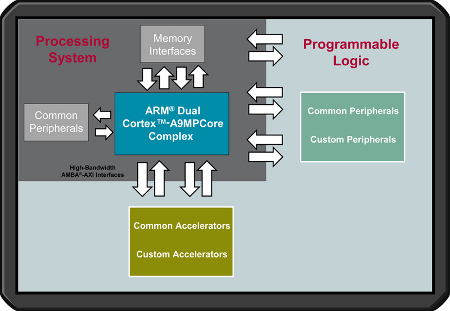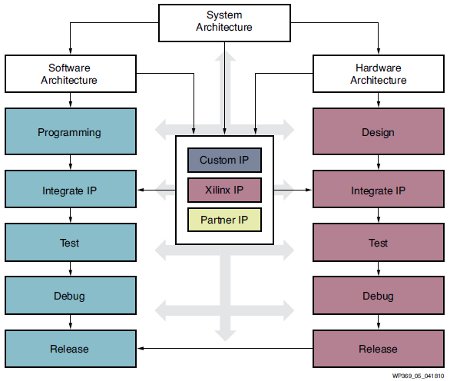Chip architecture unifies Cortex-A9 cores with FPGAs
May 3, 2010 — by Eric Brown — from the LinuxDevices Archive — 4 viewsXilinx announced a new processor architecture combining its parallel-processing FPGA circuitry with ARM Cortex-A9 MPCore processor cores. The Xilinx Extensible Processing Platform enables embedded developers to apply a combination of serial and parallel processing, with communication via a new version of ARM's AMBA interconnect standard.
In October, ARM and Xilinx announced they were collaborating to enable ARM's Cortex processors and AMBA interconnect technologies on forthcoming Xilinx FPGAs (field programmable gate arrays). The resulting Xilinx Extensible Processing Platform appears to represent a major shift for the FPGA powerhouse away from the PowerPC architecture.
PowerPC-based processors are used in current FPGA products such as the company's Virtex-II Pro, Virtex-4 FX, and Virtex-5 FXT, along with IBM's Core Connect bus. Although Xilinx said in October that it would continue to support PowerPC processors in other products, it appears that ARM represents the future for Xilinx. If nothing else, moving to ARM — and specifically to the powerful, dual-core Cortex-A9 architecture — should interest a whole new cross-section of embedded customers.
Specific processors based on the Extensible Processing Platform will be announced in early 2011, says the company. The architecture is aimed at designs that require high-speed access to real-time inputs, high-performance processing, and complex digital signal processing, says Xilinx.
Target applications are said to include automotive driver assistance, intelligent video surveillance, wireless communications, and industrial systems. In the automotive realm, for example, Xilinx sees a future for the platform in high-speed collision-detection systems that can make use of an FPGA's massive parallel-processing capabilities for near real-time response.

Xilinx Extensible Processing Platform simplified block diagram
(Click to enlarge)
The "Extensible" designs will feature the tight coupling of programmable logic with the processor system via high-bandwidth AMBA-AXI interconnects. This approach is claimed to accelerate key system functions by up to 100 times, using off-the-shelf and/or custom IP.
AMBA adds FPGA protocols
The AMBA-AXI interconnect architecture helps clear common performance bottlenecks between the parallel and serial computing environments, as well as with memory and I/O, says Xilinx. Another touted advantage is that the processor system can gain configuration control of the programmable logic, including dynamic reconfiguration.
AMBA (advanced microprocessor bus architecture) is billed by ARM as an open standard, on-chip interconnect specification for the connection and management of functional blocks on a SoC. Whereas MPCore handles communications among Cortex-A9 cores, AMBA handles other on-chip interconnect duties for interacting with other processors, memory, and peripherals.
As was announced in October, ARM and Xilinx have been collaborating on a new version of the specification designed to work with FPGAs, called AMBA-AXI by Xilinx. This appears to be the same as the AMBA 4 standard now promoted by ARM.
AMBA-4 promotes design re-use by defining a common backbone for SoC modules using specifications for AXI, AHB, APB, and ATB, says ARM. AMBA-4 adds three new interface protocols. These include an AXI4 protocol for improving performance and power efficiency, as well as two protocols that are specifically optimized for FPGAs: AXI4-Lite and AXI4-Stream.
AXI4-Lite is designed for communications with simpler, smaller control register-style interfaces. AXI4-Stream, meanwhile, is designed for unidirectional data transfers from master to slave "with greatly reduced signal routing," says ARM.
A Linux-ready development environment
Because the "Extensible" architecture is driven by the Cortex-A9, development is much easier compared to programming FPGA circuitry directly, says Xilinx. The full processor system, including caches, memory controllers, and commonly used (but so far undefined) peripherals are presented to operating systems (OSes) at power-up, providing a "software-centric development flow," says the company (see diagram below). Supported OSes are said to include Linux, VxWorks, and Micrium's uC-OSII.

Software-centric development flow with Xilinx' Extensible Processing Platform
(Click to enlarge)
Cortex-A9 background
Announced in Oct. 2007, ARM's Cortex-A9 core is billed as supporting clock speeds over 1GHz and performance of around 2,000 Dhrystone MIPS. The A9 architecture also provides ARM's MPCore interconnect technology. Last July, ARM announced two dual-core implementations of its Cortex-A9 processor. These "Osprey" designs are claimed to offer clock speeds above 2GHz.
Stated Vin Ratford, Xilinx's SVP for worldwide marketing and business development, "By creating an architecture within a familiar ARM processor-based development framework, this new Extensible Processing Platform can be the engine of innovation for many design teams held back today by performance bottlenecks."
Stated Simon Segars, president of ARM, "Taking advantage of the parallelism of programmable logic is an excellent method for overcoming cost and power challenges in systems that require significant levels of high performance. Xilinx's new architecture abstracts much of the hardware burden away from the embedded software developers' point of view, giving them an unprecedented level of control in the development process."
Availability
Pricing and availability will be announced for products based on the Extensible Processing Platform architecture in early 2011, says Xilinx. More information may be found here.
This article was originally published on LinuxDevices.com and has been donated to the open source community by QuinStreet Inc. Please visit LinuxToday.com for up-to-date news and articles about Linux and open source.